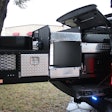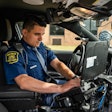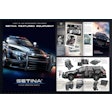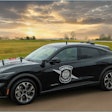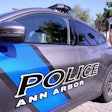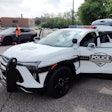 DEW Engineering makes Ford's in-the-door armor.Photo: DEW Engineering
DEW Engineering makes Ford's in-the-door armor.Photo: DEW Engineering
Armoring law enforcement patrol vehicles in the United States was once technologically and budgetarily impractical. It was also largely viewed as an unnecessary safeguard against an unlikely occurrence, an officer being ambushed in a car.
But the technology has vastly improved, making the addition of armor to patrol vehicles easier to do and less expensive. And that "unnecessary" part of the equation disappeared in the last few years as more and more officers were ambushed inside their vehicles.
• January 2016, Philadelphia—Officer Jesse Hartnett was on night patrol, sitting in his car at an intersection, when an ISIS-inspired gunman approached from the driver's side and fired 13 shots from a handgun. Hartnett was hit three times, his left arm was shattered, but he managed to kick open the door, chase after the gunman, and open fire. The gunman was wounded by Hartnett. He was arrested by responding officers.
• November 2016, Des Moines, IA—A gunman approached the patrol vehicle of Sgt. Anthony David Beminio while he was stopped at a traffic light and opened fire. Beminio was killed. Twenty minutes earlier and two miles away in the suburb of Urbandale, IA, the same gunman had killed Urbandale patrol officer Justin Martin, also while he sat in his car stopped at an intersection. In both cases, the gunman had approached from the driver's side of the vehicle and fired into the door and window.
• July 2017, New York City—NYPD Officer Miosotis P. Familia was working in a marked command post vehicle at an intersection in the Bronx. A gunman walked up to the window and fired a single shot, striking Familia in the head, and killing her. The gunman was killed in a shootout with responding officers. As is tradition in the NYPD, Familia was posthumously promoted to detective.
These four officers were not the first, nor will they be the last officers to be ambushed in their vehicles, but the attacks on them spurred law enforcement leaders in a number of U.S. jurisdictions to seek out ways to better protect their sworn personnel inside vehicles.
Inside the Door
The concept of adding armor to patrol vehicles is not new. Ford first showed its NIJ Level IIIA (handgun, shotgun) and Level III (rifle, but not armor piercing) vehicle armor at the International Association of Chiefs of Police show in 2007. The armor is offered as an option, and is now available in Level IV (armor piercing).
What is new is that demand for vehicle armor installed by the original equipment manufacturer (OEM) on patrol vehicles or installed aftermarket is rising fast.
Since 2015 Ford's in-the-door vehicle armor has been made by DEW Engineering (www.dewengineering.com), an Ottawa, Canada-based company that built its business on producing military armor for the U.S. and Canadian militaries.
Jackie Pothier, a DEW engineer and director of the company's business development, says that in addition to its work with Ford in the OEM market, the company is now branching out into making armor for vehicles that are already on the road. "It's not unusual for agencies to have wanted armored panels when they ordered the vehicle but they couldn't afford them at the time. Now they have the budget and want to add them," Pothier says, adding the company is now selling directly to agencies.
![[|CREDIT|]](https://img.policemag.com/files/base/bobit/publicsafety/image/2019/06/pm.dew-img_1210_riflefire_sz.jpg?auto=format%2Ccompress&fit=max&q=70&w=400)
DEW's aftermarket products are available for a variety of popular law enforcement vehicles, including Chevrolet and Dodge models. For aftermarket sales, DEW ships the panels directly to the agency or to the agency's upfitter for installation.
DEW has some Canadian law enforcement customers, but most of its police sales are to U.S. agencies, according to Pothier. "Violence against police is not as prevalent in Canada," she explains. Also, even though DEW is based in Ottawa, it is a fully owned subsidiary of Colorado-based Coorstek.
One concern about installing armor inside the doors of patrol vehicles is how much weight the armor adds to the vehicle and how the additional weight affects performance. Pothier says weight varies based on the protection level and composition of the armor, but DEW has a policy of never adding more than 50 pounds per door. DEW's most popular law enforcement armor panel is its Level III door panel, which weighs 42 pounds.
Pothier says that when DEW first started offering products to the law enforcement market, its Level IIIA panels were in the greatest demand. In just four years that has changed. "A lot more agencies are asking for rifle protection," she says. "Whether an officer works in the inner city or out in farm country, the rifles are out there."
Outside the Door
Pocomoke City, MD-based Hardwire LLC (www.hardwirellc.com) takes a very different approach to armoring law enforcement vehicles than its competitors. It applies the armor to the outside of the vehicle.
Hardwire CEO George Tunis says the idea for adding armor to the exterior of patrol vehicles was developed from the company's work for the military. That's why the company refers to its police vehicle armor system as a "B-Kit." In military vehicle armoring nomenclature, the vehicle itself is the "A-Kit," and the armor added to the exterior to protect the occupants from small arms fire is the "B-Kit."
![[|CREDIT|]](https://img.policemag.com/files/base/bobit/publicsafety/image/2019/06/pm.hardwire-hartnett.jpg?auto=format%2Ccompress&fit=max&q=70&w=400)
Hardwire's B-Kit armor covers the patrol vehicle's doors, and it is available for 14 different makes of popular law enforcement vehicles, including all of the pursuit-rated patrol vehicles produced by Chevy, Dodge, and Ford.
Tunis says that because Hardwire's armor is applied to the exterior of the vehicle it is easy to install. "It takes about 10 to 15 minutes for a crew of four to armor the vehicle," he explains. Also, agencies can add to the armor in order to increase the protection. "Our kits all work like Lego," Tunis says. "You can go from IIIA to III and add on just like Lego."
Tunis adds that the armor comes off as easily as it goes on. If a car is wrecked or it is being retired because of mileage, the armor can be transferred to the same make and model of vehicle. He says, "Reusing it has been a huge cost-savings for all the departments that use it."
Currently, Hardwire's B-Kit armor is in use by the Philadelphia Police Department and the NYPD. Tunis says both the officers and the public can tell that the vehicle is armored. "It makes the car look a little more muscular, not militarized, but muscular," he says, adding that officers take comfort in the "blister" on the side of their cars. "Officers rest their hands on it to confirm their vehicles are armored," he explains.
Bad guys also apparently notice the armor on the outside of the vehicle. "It's definitely a deterrent," Tunis says, adding that no police vehicle protected by Hardwire's B-Kit armor has been shot at.
Hardwire's B-Kit armor is made of Dyneema's ultra-high-molecular-weight polyethylene ballistic material. It also has a molded cover that's made of the same material as the plastic trim used on contemporary vehicles. The cover can be color-matched to the vehicle's paint, and decorated with the agency's markings.
The Clear Part
Glass is one of the greatest vulnerabilities on any law enforcement patrol vehicle. An attacker can fire into the windshield or more likely into the side windows. Armoring an SUV windshield is expensive and adds a lot of weight. But armoring the side windows is much more practical.
Patrol vehicle window armor is usually made of polycarbonate or layered glass. DEW's Pothier says customers choose the material based on the value they place on different factors such as scratch resistance.
Vehicle armor manufacturers have produced an ingenious solution to protect the driver or passenger while maintaining functionality of the window and minimizing weight and expense: They only shield the part of the window where the driver or passenger can be hit by gunfire. "It covers about half of the window," says Hardwire's Tunis.
![[|CREDIT|]](https://img.policemag.com/files/base/bobit/publicsafety/image/2019/06/pm.hardwire-transparent-armor-insert_sz.jpg?auto=format%2Ccompress&fit=max&q=70&w=400)
With both DEW's and Hardwire's window armor, the existing vehicle window stays on the vehicle, and the armor is not attached to the window but the door. This way officers can roll down their windows and talk to people while the armor stays in place. Pothier says there's no way with current technology to replace the window with the armor material and maintain functionality. "The armor would be too thick for the window slot," she says.
Patrol vehicle window armor is extremely tough, according to Tunis. Answering a question about multiple shot capabilities, he says, "You can shoot it all day and not penetrate it. At some point it just fills up with lead."
Ballistic Floor Mats
Former Cedar Rapids, IA, police officer Keith Brown gets some pretty puzzled looks and funny comments when he starts talking to his law enforcement colleagues about his Attack Mats, literally ballistic floor mats for patrol vehicles. "I've been a cop for 30 years, and I've never had anybody shoot at me from the bottom of the car," one potential customer told him.
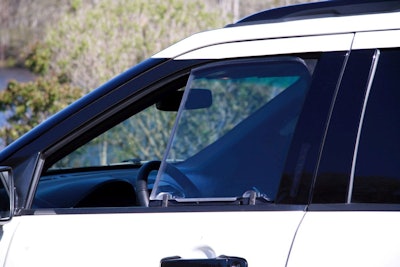 Patrol vehicle window armor partially covers the window, protecting the officer while allowing the officer to use the window for speaking to people and other operations.Photo: Hardwire LLC
Patrol vehicle window armor partially covers the window, protecting the officer while allowing the officer to use the window for speaking to people and other operations.Photo: Hardwire LLC
Brown, who served as a patrol officer for 10 years, laughs about such comments. And he quickly explains that his Attack Mats ballistic floor mats are not intended to protect officers' feet from incoming fire. They are designed to be rapidly accessible shields. "I wanted officers to have a ballistic shield that was in the car with them at all times, and they wouldn't have to pull it out of their trunks or the backs of their SUVs under fire. So I came up with the idea of ballistic floor mats," he explains. And, yes, the Attack Mats are also fully functional floor mats cut to fit the floorboards of popular patrol vehicles.
Attack Mats are manufactured for Brown by ballistic armor company Hardwire LLC, and they are made of Dyneema ballistic material that is rated NIJ Level IIIA. Which means they can stop 12-gauge slugs and a wide variety of handgun rounds, including the .44 Magnum. Attack Mats are lightweight at less than 7 pounds and designed to be held with one hand while shooting with the other. They have a built-in handle and ambidextrous straps so they can easily be held in either hand.
Pricing varies by order size. However, Brown estimates $1,500 for a pair, one driver and one passenger. That includes shipping. He says some agencies are inquiring about buying a single mat for their vehicles because they run single-officer patrols, but he hopes they will see the officer safety benefits of having two. "If an officer at a traffic stop comes under fire, they may have a better chance of getting to the passenger side floor mat first."
Attack Mats are currently being tested by a number of agencies, including the NYPD, according to Brown. "They have them in some of their cars out on the street, and have done some testing," he says, adding that they have yet to be used in actual action.
Brown is confident that when Attack Mats are shot in action they will protect the officers using them. But he admits that absorbing the impact from handgun or shotgun rounds while holding the lightweight shield in one arm is going to hurt. "It may break your arm," he explains. "But if you can go home at the end of your shift with no serious injuries that is the goal." www.attackmats.com











